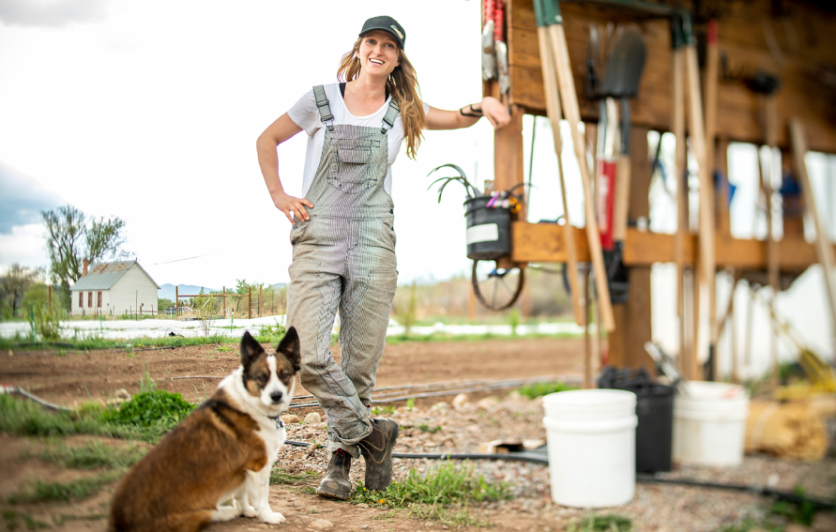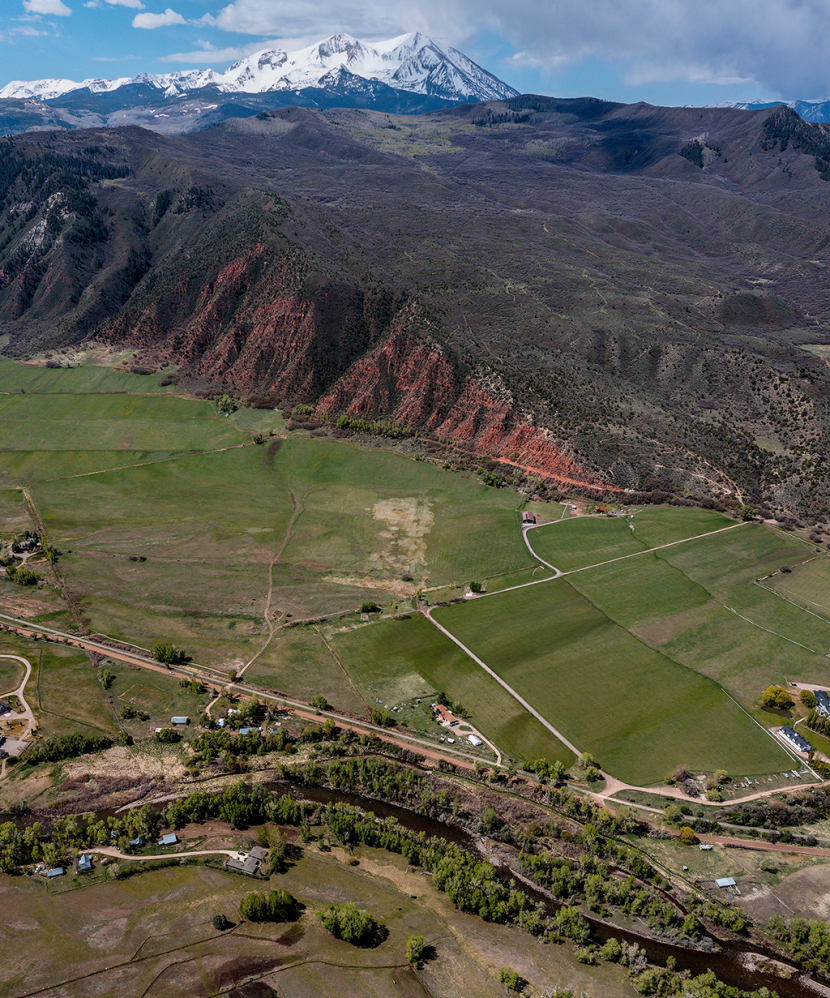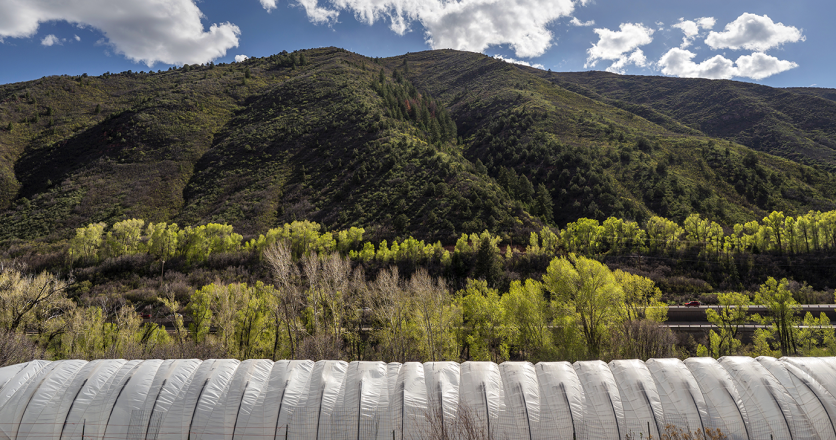Back to the Land
It’s not easy being a farmer or a rancher, no matter where you live. It’s even less feasible in a place like the Roaring Fork Valley, where land prices are at a premium, the water supply is limited, and affordable housing is scarce. These hurdles affect not only those who want to grow or graze on the land, but also consumers who would prefer to buy ingredients locally—a priority that has increased since the pandemic disrupted our food supply.
The missions of several local entities that manage land— such as Pitkin County Open Space and Trails (OST), the City of Aspen, and Aspen Valley Land Trust—include conserving agricultural tracts. But these agencies often don’t have the budget or staff, not to mention the mandate, to farm or ranch this land themselves.
Bridging the gap between the needs of farmers and ranchers and the desire to protect and maintain disappearing agricultural lands are leasing programs like the one OST established in 2014. Pitkin County leases out almost 400 acres (a few parcels even include on-site housing) for ranching and farming. In return, the county gains committed, active stewards of the land who maintain—and often improve—its health. And the local food availability gets kicked up a notch.
Small operators like Abby Zlotnick of Juniper Farm, who grows produce and flowers on a portion of the Lazy Glen Open Space near Old Snowmass, would likely not function without the subsidized land and water. “It 100 percent enables me to be a farmer in this valley,” she says. “I’m really grateful.”
But are the entities involved with agricultural leasing and preservation collectively doing enough to help diversify the local farmer base and ensure equitable distribution of the land? It’s an important point to consider as the desire (and need) increases for local food and the lands that produce it.
Growing a program
Since its creation in 1990, when county voters approved a property tax to acquire open spaces and develop trails, OST has conserved 20,000 acres; today it maintains almost 150 miles of hiking, biking, and Nordic trails. Agricultural properties have been among its acquisitions for the last 20 to 25 years, says OST Director Gary Tennenbaum, but other than a few handshake agreements with ranchers already running livestock, no official process existed to optimize land management for agricultural uses.
That changed after a board retreat in 2014, when OST was charged with instituting a formalized leasing process to emphasize local food production and incentivize residents to farm. The new program was modeled after one in Boulder County that has been in place since the 1970s. Now Boulder and Pitkin are the only counties in the state to have a dedicated agricultural leasing program (nationally, counties from Sonoma in California to several in New Jersey offer
similar deals). To acquire a lease in Pitkin County, applicants must go through a competitive bid process that includes explaining in detail not only their production goals and background, but also how they would conserve the soil, water, and native vegetation. That emphasis on good land management resonates with young growers like Harper Kaufman, who runs Two Roots Farm on 22 leased acres at the Emma Open Space near Basalt.
“I respect the county for looking at applicants and trying to gauge their ability to manage land in a way that’s regenerative and with a holistic mind-set,” she says. “It would be easy to just pick a lessee with a good business model.”
At Two Roots, for example, where Kaufman grows 40 types of veggies plus herbs and flowers, she uses regenerative measures like cover cropping to build organic matter and minimal tillage to help microorganisms in the soil thrive.
The eventual leaseholder then rents the land at a below-market rate—averaging $25/acre per year—which includes water rights, crucial in arid Colorado. For comparison, irrigated land in the state’s northwest and mountain communities averages $39.50/acre, according to the USDA’s National Agricultural Statistics Service. Those fees—about $8,000 per year total—are invested directly back into the program. OST regularly monitors the growers and their impact on the land. Lease terms generally run for five or 10 years to allow a new operation time to establish itself; when a lease is up, the land goes back out for bid, and the existing farmer or rancher can reapply.
With county approval, lessees can also sublease a portion of their land to other growers, at the leaseholder rate or lower—one way to get more farmers on the limited land available and, ideally, more food grown. Zlotnick subleases her acre from Cooper Means, who has 10 acres overall for raising sheep and chickens and producing grain. Kaufman is subleasing a back pasture this summer to Alyssa Barsanti, who recently won a bid for a lease on the Glassier Open Space near Basalt; the sublease allows Barsanti to graze her sheep and chickens while she sets up her own operation.
Reaping the benefits
As of this spring, OST oversaw 16 lease areas being used by 14 farmers or ranchers (including sublessees; some primary lessees hold more than one lease), according to Paul Holsinger, Pitkin County’s agricultural and conservation easement administrator. They range from larger operations like Woody Creek Distillers, which grows potatoes on the Wheatley Open Space near Old Snowmass, and Mountain Primal Meat Co., which grazes Highland cattle on Emma’s Shippee Open Space, to Alex Parker, who produces hay on 40 acres at Glassier Open Space near Basalt, and a two-person flower business on a half-acre also at Glassier.
In addition to boosting local food sources, conserved agricultural lands provide many of the same benefits as other Pitkin County open space: green buffers, wildlife habitat, rural character, and—significantly—diverting properties from high-end residential development.
“The reality of the Roaring Fork Valley,” says Tennenbaum, “is that the ‘highest and best use’ of a piece of land is not in agriculture, it’s in residential development. If left up to the private sector, we wouldn’t have agricultural lands. We’re ensuring that agriculture continues.”
It’s not only county administrators that feel this way. In a 2018 survey of Pitkin County residents, more than two-thirds supported zoning to increase food production and agriculture, with 46 percent calling it a “great benefit.” Local consumer demand is high, too. Two Roots Farm’s CSA, for example, which serves some 200 families, sold out by the end of March.
Not surprisingly, the lease program has its critics. As interest in applying for leases has grown, so has competition among bidders; a recent applicant who did not win a bid charged that the evaluation was unfair, which brought more scrutiny to the process (though Pitkin County had already committed to reviewing some procedures later this year).
Some local growers who paid market value for their own land complain that lessees get an unfair leg up. Holsinger counters that anybody is welcome to apply for a lease. “Our mission is to support agricultural and wildlife habitat and water. We’re just trying to maximize stewardship and the best thing for the land.”
In fact, some current lessees already have land of their own. Longtime rancher Bill Fales leases some 40 acres in the Thompson Creek Open Space west of Carbondale to supplement the 620 acres at his own Cold Mountain Ranch, which has been in the family for 97 years, and land at Coffman Ranch (more on that later). It gives him a separate place to winter his bulls after the land he previously used was sold and provides lower-elevation grazing for the rest of the herd in spring. “It would take the Berlin Wall to keep bulls apart from your cows when the cows come into heat,” he says.
Meanwhile, OST benefits from Fales’s progressive land management approach, like introducing rotational grazing into areas that had historically been grazed as one unit. “I’m not happy with just ‘sustainable,’” says Fales. “I want to be improving.”
Other players
Though it’s currently the most active local land organization prioritizing agriculture, OST isn’t the only one doing so. The City of Aspen oversees 1,100 acres of open space, including the 168-acre Cozy Point Ranch near Highway 82 and Brush Creek Road, purchased in 1994 to preserve its agricultural heritage. An equestrian center and the nonprofit Farm Collaborative (publisher of Edible Aspen) lease their acreage from the City; in April, the Collaborative received final land-use approvals for the Farm Center, a new headquarters for education and events, further underscoring local government’s commitment to agriculture.
And while Aspen Valley Land Trust (AVLT) has long included agricultural protection in its mission—the majority of its 44,000 acres of conservation easements is on some type of agrarian land, says Executive Director Suzanne Stephens—the 54-year-old nonprofit enters a new phase with plans to buy and manage a ranch. The 140-acre Coffman Ranch is less than two miles from downtown Carbondale and includes a mile of frontage on the Roaring Fork River as well as untouched riparian habitat. A dairy farm long ago, the property has been used by Fales for part of his cattle operation for the past 30 years.
In addition to keeping it a working ranch, AVLT plans to turn the site into an “ambassador property,” says Stephens, with educational events, viewing blinds, and short trails to let people experience the conservation process up close. In the future, some of the land could be leased to small farmers. “It could be an opportunity to partner with other nonprofits or to lease to groups that don’t have access to land as readily,” she adds.
AVLT has no plans to acquire more ag properties, but it supports local food production in other ways, too. For example, AVLT helped the Town of Silt acquire open space for Highwater Farm, which provides training and jobs for local youth, donates 25 percent of its produce to local food banks, and sells the rest at farmers’ markets.
Planting the seeds of equity
One question looms large over the OST program: How to make the leaseholder pool better reflect the cultural and racial diversity of the Roaring Fork Valley, truly bringing this communal land into the hands of the entire public.
“Our community could do better in bridging that gap,” says Kaufman. “A lot of folks in our valley have agricultural backgrounds. There might be people who are unaware of the lease program that have a lot of experience and are well poised to manage a farm.”
Tennenbaum says OST is eager to expand its outreach but needs community partners to help it do so. “Can we give 10 acres to 20 acres to a local nonprofit to engage the Latino community to grow?” he speculates. “I’d love to have more people have more food security. The pandemic was really an eye opener.”
Answers could come when OST reviews the lease bid process with the help of an outside facilitator, which Tennenbaum hopes will happen this fall. Part of the review, he adds, would focus on how to diversify the applicant pool, whether that means designating certain pieces of land for minority farmers, trying different ways of reaching new potential growers, or other approaches. It is worth noting that around half of Pitkin County’s lessees are women (many of them young and in the early stages of their careers)—higher than the 36 percent of farmers nationally who are women, according to the USDA’s most recent Census of Agriculture.
No matter who’s working the land, this much is true: Nobody is getting rich off farming, even with the help of subsidies. But things like Pitkin County’s lease program are necessary to create any kind of viable local food economy. Preserving tracts from development and then keeping them in production, says Tennenbaum, “is the only way we’re going to see agriculture on a scale that could feed this valley.” ❧







